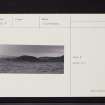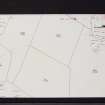Bucharn
Cairn (Prehistoric)
Site Name Bucharn
Classification Cairn (Prehistoric)
Alternative Name(s) Bucharn, Round Cairn
Canmore ID 36205
Site Number NO69SE 3
NGR NO 65935 93010
Datum OSGB36 - NGR
Permalink http://canmore.org.uk/site/36205
- Council Aberdeenshire
- Parish Strachan
- Former Region Grampian
- Former District Kincardine And Deeside
- Former County Kincardineshire
NO69SE 3 65935 93010.
(NO 6593 9300) Cairn (NR)
OS 6" map, (1959)
A cairn of rounded stones about 100' in diameter and 30' high.
Name Book 1864.
A cairn of bare stones c.27.0m in diameter and 4.5m high. It stands on a platform about 33.0m in diam. and 0.8m high which may be original although accentuated by ploughing. It is similar to NO69SE 2 though better preserved. A semi-circular heap of stones to the W seems to be entirely field clearance.
Resurveyed at 1:2500
Visited by OS (A A) 11 August 1972
Visible on air photographs AAS/93/06/G15/12-15. Copies held by Grampian Regional Council.
Information from Mrs M Greig, Grampian Regional Council, March 1994.
(Location cited as NO 6593 9300: nominated as Site of Regional Significance).
This platform cairn is situated on a shelf at an altitude of 170m OD.
[Air and ground photographic imagery listed].
NMRS, MS/712/35.
Publication Account (1986)
This massive round cairn of bare stones is spectacularly sited at the edge of a hill terrace with wide views across the River Feugh and up into the Forest of Birse. It is 27m in diameter and 4.5m high, but the platform on which it sits is probably the result of field clearance and ploughing. The cairn is intervisible with another of similar size c 1km to the east (NO 668933), while the dyke immediately to the east runs over a smaller cairn.
Information from ‘Exploring Scotland’s Heritage: Grampian’, (1986).
Publication Account (1996)
This massive round cairn of bare stones is spectacularly sited at the edge of a hill terrace with wide views across the River Feugh and up into the Forest of Birse. It is 27m in d iameter and 4.5m high, but the platform on which it sits is probably the result of field clearance and ploughing. The cairn is intervisible with another of similar size c 1 km to the east (NO 668933), while the dyke immediately to the east runs over a smaller cairn.
Information from ‘Exploring Scotland’s Heritage: Aberdeen and North-East Scotland’, (1996).
Laser Scanning (28 January 2014)
NO 65935 93010 A survey was undertaken of this site on 28 January 2014. Bucharn Cairn comprises an oval mound of stones averaging c0.3m across, and stands to a height of 4.1m above the lower platform, but over 6.2m in total height to the lower platform on the downslope side. The central cairn is oriented with long axis E–W, measuring 23m by 18.5m. There is no visible evidence of a chamber or other internal structures; it is probable that these remain undisturbed.
The platform consists of a bank of large boulders forming a rounded trapezoid which forms a roughly level platform respecting the central cairn. Although the platform has clearly been added to with recent field clearance, particularly in the NE area where several large boulders rest on the surface, it seems likely that this platform was designed to provide a
level surface onto which to build. Large boulders embedded in the platform in the SE and NW suggest that the outer face of the platform may be comprised of large set stones, but the majority are buried.
Immediately to the W of the cairn is a large mound of stone, similar in character to the platform onto which the cairn was built. The RCAHMS considered this mound to be modern field clearance, and there are certainly large boulders overlying the mound that appear to have been added relatively recently, but the similarity in construction to the cairn platform must raise the possibility that this was a similar platform feature
associated with the prehistoric construction. While there is no evidence to tie this feature definitively to the cairn, the presence of large boulders protruding from the outer faces of the mound in a similar manner to the cairn mound might suggest that the structure was built rather than dumped as field clearance.
Both the cairn and the mound to the W have been used as the basis for later construction. In the case of the mound to the W, at least two and possibly three buildings have been constructed. Structures 1 and 2 are congested with rubble, but appear to form two small conjoined cellular buildings. Structure 3 may be similar, but is obscured with large boulders
probably deriving from clearance. A linear stretch of walling (feature 4) may represent the remains of an enclosure around the structures on the mound. A series of set boulders on the SE side of the mound (feature 5) may, perhaps more speculatively, represent a further structure.
The cairn itself shows evidence of numerous interventions into the rubble mound, and it is not clear which of these represents the construction of a small building or shelter, and which may be the result of haphazard digging into the mound. Structure 6, on the SW side of the platform is similar in character to the buildings constructed on the mound to the W, but is in a ruinous condition. Of the buildings constructed at the foot of the mound and on the mound itself, 7, 8, 9 and 11 are the most substantial, but several other smaller cells have been dug across the top of the cairn. Structure 10 is upstanding and may represent a relatively recent shooting butt or similar ad hoc structure, but the precise nature and date of these structures remains to be determined. A small cairn, probably of relatively recent date, has been built on top of the cairn (feature 12), overlying structure 9.
Surrounding the cairn are numerous hollows and mounds. It is probable that these indicate the presence of buildings similar in character to those constructed on and around the cairn. The scope of the present survey did not extend to detailed recording of these structures, but one scooped hollow is located immediately to the S of the cairn, spanning the modern fence. It is possible that these features represent the remains of an historic settlement surrounding the cairn. It is difficult, however, to be confident of their character or date.
Archive: RCAHMS (intended)
Funder: Forestry Commission Scotland
Graeme Cavers and Gemma Hudson – AOC Archaeology Group
(Source: DES)
















